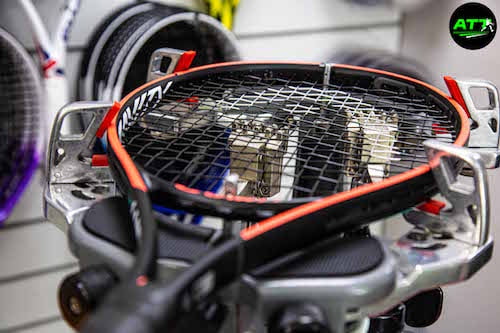
Reinventing the Racket
“Reinventing the Racket”, is designed “to show people that rackets are not boring”, according to its curator Matthew Glaze, who is the museum’s Collections Development Officer. And it achieves that aim in style by showcasing not only the progression in racket design, but also some of the weird and wonderful rackets that have emerged from the struggle to get ahead of the competition.
It all started in the mid-1870s (approximately 1875) when Major Walter C. Wingfield made a solid wood racket that sold well in major locations around the world such as Russia and China. An example is on display in the exhibition, so visitors can see that it had a much smaller head and a much longer handle than modern rackets.
A flood of competing efforts soon emerged, and the first wall of the exhibition displays examples of rackets with bent heads or symmetrical heads and strings made of either gut, metal or twine. It is fascinating to see how these early rackets looked, and it gives a great insight into the concept behind racket design. It shows that the creators were already searching for the ideal head size and shape, the perfect grip (they even tried sheepskin) and the right material to use for the strings.
After most of the manufacturers eventually settled on a symmetrical head, they turned their attention to handle design, and in the first quarter of the 20th century a variety of styles were available to players. The most popular designs were the classic (similar to modern day) and the Demon, which had its wood shaped into a fishtail at the bottom end. Fine examples of both are on display in the exhibition, along with bulbous, barrel and button handles. It is unclear whether handle design made any discernible difference to their user’s playing standard, other than in terms of weight distribution, so the varieties may owe their existence largely to aesthetic preferences.

The late 19th century and the early 20th century also spawned a few of the earliest incarnations of metal rackets, but they were all too prone to rust and proved unsuccessful. In 1965, after the post-war switch from handmade to machine-made rackets, Rene Lacoste changed all of that when he created a metal racket with an almost-perfectly-round head and a trampoline stringing method – and his superb creation is on display in the exhibition. Lacoste’s innovation inspired Billie Jean King to use a metal racket from 1970 onwards, but many top players of the time still preferred to use wooden rackets.
As well as charting the history of the racket, the exhibition showcases marketing posters and some of the most ornate rackets ever made, many of which incorporated elegantly-laminated wood (different pieces of wood stuck together to create a stronger frame), colourful lines and finely-detailed handles. Some even had pictures and signatures of the major players who used them. Glaze said he was keen for people to see ‘how beautiful they are’.
The exhibition also displays rackets involved in the Slazenger & Sons v Feltham & Co court cases. In 1888, Slazenger took Feltham to court for infringement of trademark when Feltham made a very similar racket to Slazenger’s Demon design and named it Demotic. Slazenger won the case, but Feltham appealed the ruling, and in 1889 the court decided that Feltham could continue to sell their similar rackets provided they remove the word Demotic from them.
And then there were the bizarre rackets. In one particularly interesting corner of the exhibition, there is one racket with a bent, ergonomic grip, one with a supposedly “indestructible” plastic coating, one with adjustable tension strings and one with a double layer of strings designed to increase power. To top it all off, there is the Pirelli shock-absorber racket, which remains the most-expensive racket ever-created at £750 recommended retail price.
After the wood, the metal and the bizarre, graphite rackets emerged in 1978 as the superior iteration. They are lighter, five times stronger than aluminium rackets and thirty times stronger than wooden rackets. And they have arguably rendered modern-day rackets a bit boring, as there do not seem to be many improvements that can still be made to the design of the racket. Manufactures will still try, of course, as the connected technology Babolat racket on show here demonstrates.
In all, there are 87 rackets on display in this superb exhibition, with two borrowed and the rest taken from the All England Club’s collection of 900 rackets. And curator Glaze does not need to worry: they are certainly not boring. In fact, the chances are that visitors to the exhibition will be much more interested in the tennis racket and its history when they leave than they were before they arrived, particularly if the planned ‘making of’ display, which will show the processes for making wooden and metal rackets, is added.
- Join the tennishead CLUB and receive £250/$350 of FREE GEAR including ASICS Gel-Resolution 8 trainers, shorts, shirt & socks
- Keep up to date with the breaking news & tennis action at our tennis news section
- Win amazing prizes by entering our competitions
- Learn more about your favourite players including Roger Federer, Rafa Nadal and Novak Djokovic
- Check out the latest tennis equipment with our tennis gear reviews
- Receive regular updates in our legendary free newsletter
- Read in depth features with stunning photography in tennishead magazine
- Can’t visit the tournaments you love? Check out our guide on how to watch tennis on TV
- Don’t miss a thing with our Live Scores service
- Follow tennishead on social media at Facebook, Twitter, Instagram & YouTube
- EXCLUSIVE 5% DISCOUNT for all tennishead readers on tennis rackets, balls, clothing, shoes & accessories with All Things Tennis, our dedicated tennis gear partner


